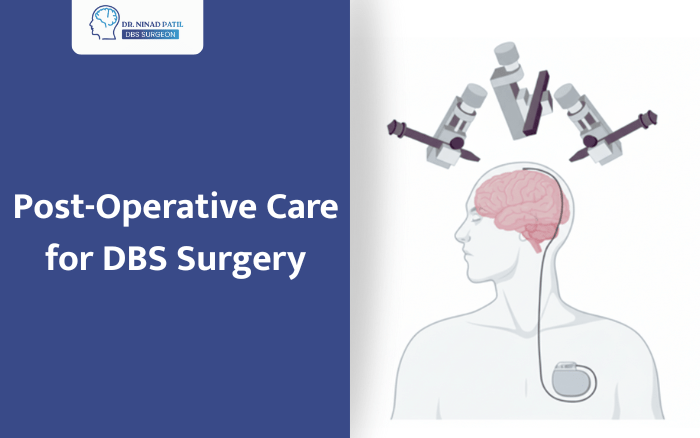Going through Deep Brain Stimulation (DBS) surgery is a big milestone. For many people living with conditions like Parkinson’s disease, dystonia, or essential tremor, this surgery can bring new hope and relief. But here’s the important part, recovery doesn’t end once the surgery is over. The way you take care of yourself in the days, weeks, and months after surgery has a huge impact on how well you heal and how much benefit you get from DBS.
This blog will walk you through what to expect after DBS surgery, practical care tips, and the role of follow-up visits. Whether you’re a patient or a caregiver, you’ll find clear steps to make recovery smoother and safer.
What Happens Right After DBS Surgery
➣ The First 24 Hours
After your surgery, you’ll stay in the hospital for monitoring. This is completely normal. The medical team will check your vital signs, watch for any immediate side effects, and make sure you’re comfortable.
You might feel some pain around the incision sites on your head and chest. This is expected. Most patients describe it as similar to a bad headache combined with soreness where the device was placed under the skin.
Important signs to watch for:
- Fever above 101°F
- Severe headache that gets worse
- Nausea or vomiting that won’t stop
- Confusion or difficulty speaking
If you notice any of these symptoms, tell your nurse right away.
Pain Management That Works
Your doctor will prescribe pain medications to keep you comfortable. Take them as directed – don’t try to tough it out. Managing pain properly actually helps you heal faster.
Ice packs can also help reduce swelling around the surgical sites. Apply them for 15-20 minutes at a time, with breaks in between.
Your First Two Weeks at Home
➣ Taking Care of Your Incisions
Keeping your surgical sites clean and dry is crucial during DBS surgery recovery. Here’s how:
- Gently clean around the incisions with mild soap and water
- Pat dry with a clean towel – don’t rub
- Don’t soak in baths, hot tubs, or swimming pools
- Short showers are usually okay after 48 hours (ask your surgeon first)
➣ Watch for infection signs:
- Increased redness or warmth
- Pus or unusual drainage
- Red streaks extending from the incision
- Worsening pain instead of improvement
What to Expect During Recovery
The first week can be challenging. Many patients experience:
- Headaches that come and go
- Scalp tenderness around the device
- Some swelling at the surgical sites
- Feeling more tired than usual
- Difficulty sleeping comfortably
These symptoms are normal and should gradually improve. However, if anything seems to be getting worse instead of better, contact your medical team.
Activity Guidelines
For the first two weeks, take it easy. Your brain and body need time to heal.
➣ You can:
- Walk around your home and neighborhood
- Do light household tasks
- Read, watch TV, or use your computer
- Eat your normal diet (unless told otherwise)
➣ Avoid:
- Lifting anything heavier than 10 pounds
- Strenuous exercise or sports
- Driving (until cleared by your doctor)
- Bending over repeatedly
- Activities that could cause you to fall
Weeks 3-6: Getting Back to Normal
As you enter the third week, you should start feeling more like yourself. The initial healing is usually complete, and you can gradually return to more activities.
➣ Preparing for Programming
One of the most important parts of DBS surgery recovery is the programming process. This usually starts 2-4 weeks after surgery, once the swelling in your brain has gone down.
During programming appointments, your neurologist will:
- Turn on your DBS device for the first time
- Test different settings to find what works best for you
- Adjust your medications if needed
- Monitor how you respond to the stimulation
Don’t expect immediate perfect results. Finding the right settings takes time and patience.
Warning Signs to Never Ignore
Call your doctor immediately if you experience:
- Sudden worsening of your original symptoms
- New weakness or numbness
- Speech problems
- Severe mood changes
- Any symptoms that concern you
Frequently Asked Questions
1. How long does it take to fully recover from DBS surgery?
Most patients feel better within a few weeks, but full recovery and adjustment to the DBS device can take several months.
2. Can patients go back to normal activities after DBS?
Yes, with time. Daily activities are gradually reintroduced, and most people return to their normal routine once cleared by their doctor.
3. Are there risks of infection after DBS surgery?
Like any surgery, infection is possible but rare. Proper wound care and timely follow-ups help lower the risk.
Book Your DBS Recovery Consultation with Dr. Ninad Patil
Recovery after DBS surgery is a journey. From wound care and rest in the early days to follow-up visits and device programming in the months that follow, each step matters. With the right guidance, patients can regain independence and feel more in control of their symptoms.
If you or your loved one has undergone DBS surgery, don’t leave recovery to chance. Dr. Ninad Patil, DBS surgeon in Pune at Alpha Superspeciality Clinics, has guided many patients through successful post-operative recovery. Book a consultation today and take the next step toward safe and steady healing.


